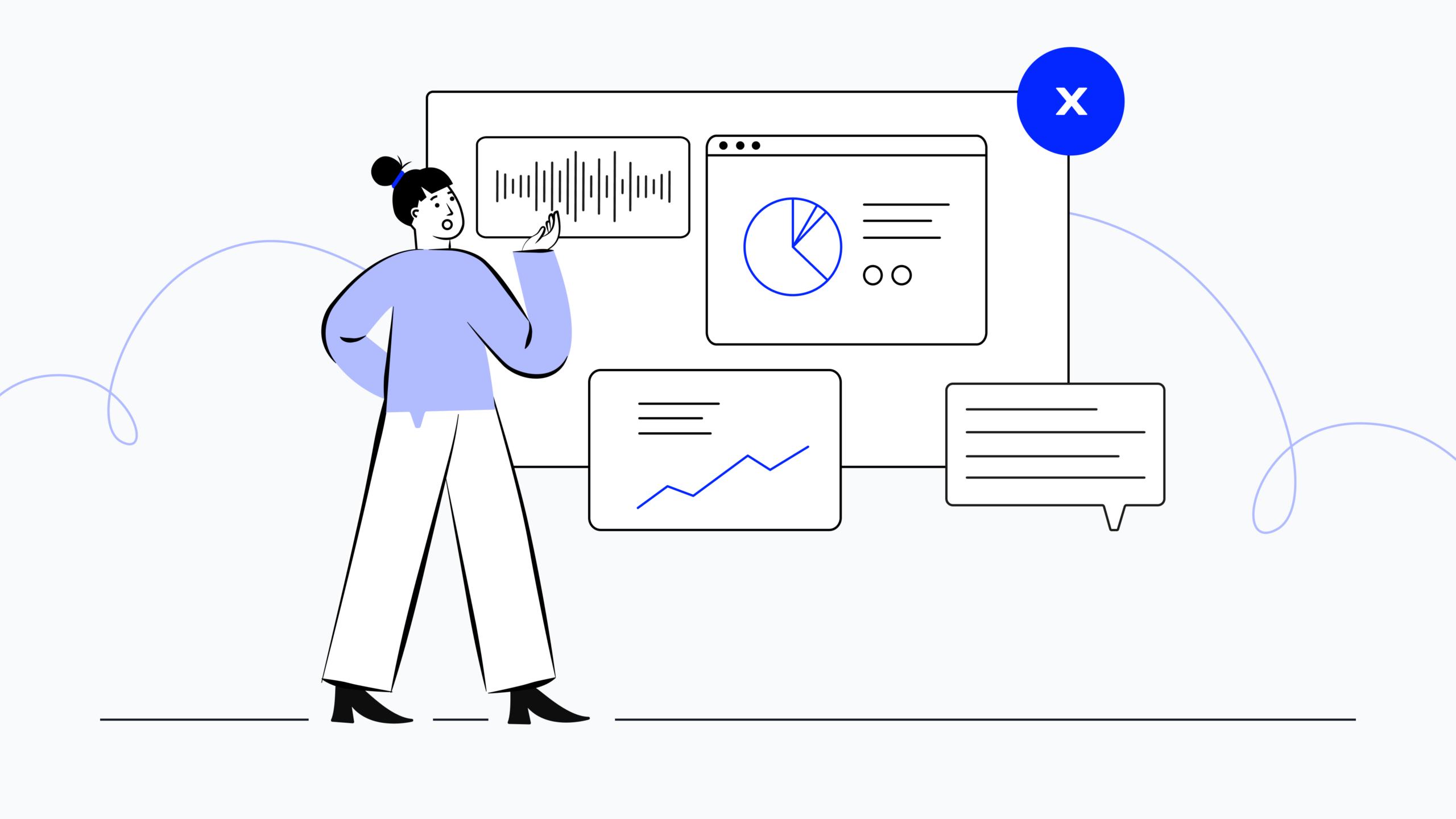
The best contact centers resolve over 90% of queries on their first contact with the customer. But what’s the trick to answering these questions so quickly?
It requires a good degree of strategic planning and process optimization. And that’s where Contact Center Workforce Management comes in. In this article, you’ll learn about what it is, its key components, benefits, and best practices.
Key Takeaways:
- Contact center workforce management (WFM) coordinates staffing and scheduling to optimize resources. By predicting call volumes and scheduling agents appropriately, companies can reduce wait times and improve the customer experience.
- Implementing contact center workforce management leads to several positive outcomes, including improved customer satisfaction, streamlined administrative tasks, and cost savings.
- Best practices such as promoting a positive work culture, offering schedule flexibility, and cross-training agents in various skills are essential best practices for maximizing contact center efficiency.
What Is Contact Center Workforce Management?
Workforce Management (WFM) involves strategically planning and organizing a company’s personnel and resources to improve efficiency and achieve business goals. It consists of scheduling team members to ensure the right number of skilled employees are available at the right time and place.
In a contact center, workforce management software considers the call volume and schedules agents accordingly, ensuring there are enough agents to handle the calls.
It guarantees that the right agents with the right skills are working when they’re needed most, so customers get help as quickly as possible.
Discover 10 Proven Methods to Increase Productivity in Your Call Center
Benefits of Workforce Management for Contact Centers
Apart from faster and more accurate forecasting and scheduling, here are some benefits that WFM brings to contact centers:
#1 Improve Customer Experience
If you use contact center workforce management software, you can plan the number of employees you need, predict the amount of work, and organize schedules effectively.
Ultimately, you ensure that your customers receive excellent service across all communication channels you use.
#2 Save Time on Administrative Tasks
As AI takes into account staffing forecasts, call volumes, and agent availability, time spent on administrative tasks such as scheduling and assigning agents is reduced.
#3 Increase Job Satisfaction
Poor team management could lead to understaffing, putting more pressure on agents and affecting their well-being and job satisfaction. This could lead to exhaustion, resulting in absences, sickness, and even resignations.
According to a study, turnover rates in call centers range from 30% to 45%, higher than in other industries.
Similarly, overstaffing can result in lower motivation and commitment, also negatively affecting job satisfaction.
With workforce management software for contact centers, you can accurately predict how many agents you need. This allows you to create regular schedules and avoid overloading, which increases employee satisfaction and retention.
#4 Save Money
Efficient employee management also helps you to control expenses better, as you can more accurately forecast how many employees you need. In addition, you also avoid wasting resources by having too many people working when it’s not necessary.
Moreover, by keeping your employees happy and satisfied, you can save money on hiring processes to replace your agents.
#5 Ensure Compliance
Workforce management systems (WFM) for contact centers guarantee that employees adhere to their schedules and take breaks and vacations according to labor regulations.
This way, you can prevent potential fines and surprises.
5 Key Components of Contact Center Workforce Management
Creating an efficient contact center workforce management system relies on having several essential components in place. These components ensure that staffing, scheduling, and performance tracking align with the call center operations’ demands.
#1 Forecasting
Forecasting involves estimating the volume of future calls and the number of agents needed to handle those calls. It uses historical data on seasonal peaks, volume trends, and year-over-year changes to predict staffing needs.
Forecasting helps plan the number of agents required, ensuring that there is always enough staff to handle call volumes without excessive wait times. This guarantees that customer calls are answered promptly, improving their experience and satisfaction.
#2 Scheduling
After forecasting, it’s time to use the data gathered to prepare schedules for your contact center. Scheduling involves planning the number of shifts and hours needed to cover the forecasted call volume. Tools like employee scheduling software can simplify this process, helping managers create and adjust shift plans more efficiently.
Effective scheduling ensures that the right number of trained agents are available at the right times to meet service levels.
#3 Assigning Agents
The next step after scheduling is assigning your representatives to shifts based on their experience, specialization, skills, and shift preferences. Assigning agents based on these aspects will help maximize your agents’ productivity.
On the one hand, each agent works in the area where they can contribute the most and be most efficient. On the other hand, agents will also work happily if their personal preferences are taken into account.
For example, imagine that your contact center receives a high volume of calls from customers needing technical assistance, billing support, and inquiries about new products.
To make assignments, the following factors would be considered:
- Availability and skills: Information about each agent’s availability and skills is collected. For example, some agents are experts in technical support, while others specialize in billing.
- Labor Regulations: Schedules must comply with labor regulations, such as break times and maximum working hours.
- Agent Preferences: Pay attention to agents’ personal preferences, such as preferred schedules or availability restrictions due to personal commitments.
#4 Day-to-day Management
In a fast-paced environment like a contact center, unexpected events are inevitable.
That’s why supervisors must adjust the initial planning if unforeseen circumstances happen in day-to-day operations. For example, there might be a surprising increase in call volume or agent absences (due to illness).
To do so, it’s essential to constantly monitor real-time data and adjust agent schedules to ensure a high-quality experience and that there are enough representatives to handle the additional workload.
#5 Performance Data
Measuring your team’s performance is essential for several reasons. By tracking metrics such as resolution rate or abandonment rate, you can identify your team’s strengths and weaknesses and see in which areas you can improve.
By using reporting and analytics tools within a contact center workforce management solution, you can understand your team’s performance comprehensively.
Ultimately, if you measure your team’s performance regularly, you can boost their efficiency and customer satisfaction and drive overall organizational success.
Essential Tools of Contact Center Workforce Management
Workforce Management Software
The workforce management software lets you schedule, train your team, and optimize your call center workflow from a single platform, thanks to features such as:
- Automatic Call Distributor (ACD): This system automatically directs all incoming calls to specific organizational departments or agents based on predefined distribution rules. It ensures that inquiries are handled by the appropriate individuals, saving time on each call.
- Auto Dialers: There are different types, such as Power Dialers, which allow you to organize your call campaigns, or Smart Dialers, letting you import phone numbers from websites or CRMs with a single click. This saves your agents time on manual dialing and allows them to focus on serving customers or prospects.
- Analytics: With Analytics, you can view real-time data such as total calls, total answered calls, average conversation time, and missed calls.
- Skill-based Routing: It allows you to assign customer calls to agents who possess the appropriate skill set. This improves first-contact resolution and enhances the overall customer experience.
Customer Relationship Management (CRM) Software
Customer Relationship Management (CRM) software is crucial in customer service centers for several reasons:
- Unified desktop for agents: Agents can access all the tools they need on a single screen without switching between different windows, which improves their efficiency and reduces errors.
- Personalized interactions: Customer inquiries can be automatically assigned to the most suitable agent based on language, location, and previous conversations. This provides better customer service.
- Consistent support across all channels: CRM data is shared across all communication channels, such as phone, email, and chat. This means agents always know what has happened before, no matter how the customer has communicated.
In addition, if you integrate your CRM tools with workforce management contact center software, you’ll gain the advantages of both: streamlining processes and boosting agent productivity.
Contact Center Workforce Management Best Practices
Follow these tips to empower your workforce and drive organizational success:
#1 Promote a Positive Work Culture
When employees feel valued, they are more motivated to adhere to their assigned schedules and engage in their work.
This sense of appreciation can come from various sources, such as recognition from superiors or support in professional development and advancement within the company.
#2 Offer Schedule Flexibility
It’s important to provide your employees with some flexibility in their schedules so they can better balance their personal and work lives. This not only improves their job satisfaction but also increases their productivity.
#3 Train in Cross-Functional Skills
Training your employees in different areas allows them to handle different inquiries. It is really helpful during busy times or when there isn’t enough staff.
#4 Consider Availability
Take into account when your employees are unavailable to take calls due to breaks, meetings, training, etc. Ignoring this could leave you short-staffed and your employees feeling overwhelmed.
#5 Plan Activities for Low-Volume Periods
You can plan activities in advance to keep your employees engaged, motivated, and productive during less busy times.
You can encourage professional development activities, such as participating in webinars or reading relevant industry articles.
#6 Use Real-time Analysis
Constantly monitoring your employees’ availability and call volume lets you quickly adjust schedules and assignments to avoid long wait times and abandoned calls.
Maximize Contact Center Efficiency with CloudTalk
In summary, Contact Center Workforce Management (WFM) optimizes efficiency by planning staff effectively to meet customer needs.
It ensures timely service, improves satisfaction, and saves time and money. You can take advantage of these advantages by following best practices like positive work culture and real-time analysis.
Boost your organization’s productivity with Cloudtalk’s Call Center Workforce Management Software. Streamline scheduling, coaching, and workflow optimization in one place to fuel your organization’s growth.
Learn more by clicking the button below.
Streamline Success with Call Center Workforce Management Software

















